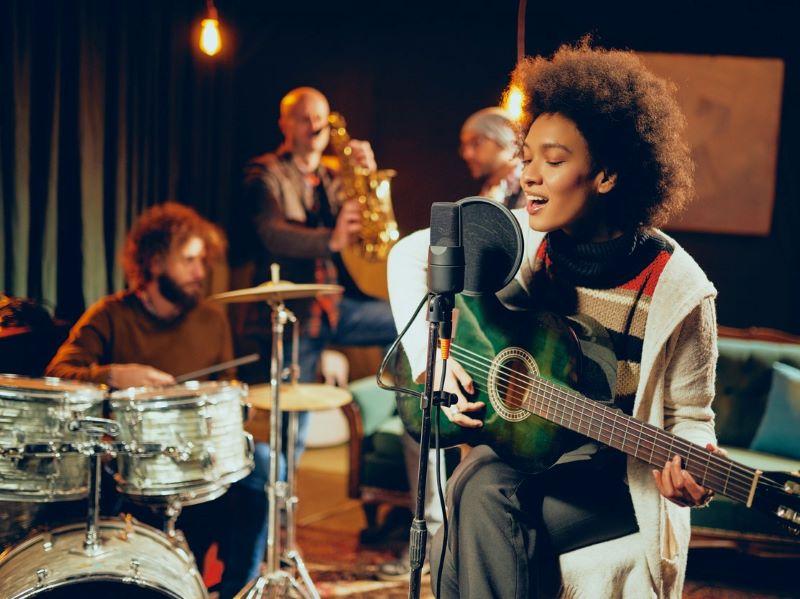
How Mozart and the arts can help students feel less awkward

Campus life has been weird over the past few years. Few of us feel at ease – in our own skins or with each other. A pandemic and other fracturing global crises have marked most students’ university careers thus far. Moreover, mounting tensions have been piling on to a baseline of social anxiety and isolation.
Unlike their predecessors, many college students have been physically separated from their classmates during their courses. Just two years ago, nearly 5 million US college students took all their courses online. Unsurprisingly, the US surgeon general has flagged an epidemic of social disconnection that is hitting college campuses with special virulence.
Now it’s back-to-school time again. Will students be able to look one another in the eyes? How can our classrooms hold us together?
The broad consensus is that in-person coursework is more likely than online learning to foster peer connection. The noticeable erosion of that connection over the past few years has led us to try taking the in-person experience several steps further. We wanted to bring the body back into the classroom, to risk a more multi-sensory approach to learning.
- Resource collection: The post-pandemic university: how to serve the Covid generation
- Make a difference: collaboration and participation in arts-led research
- How real-world experiences can help creative arts students create real-world change
Call it physical re-education.
At New York University (NYU), where we teach theatre, music, dance and literature, we formed the Consent Lab in 2022, as an academic contact zone that we see as necessary for learning. In defiance of the brittleness of campus dynamics and a general state of awkwardness, our curriculum gives students low-stress chances to confront each other, face to face and toe to toe, in potentially antagonising – even agonising – set-ups.
Consent Lab is not group therapy or yoga. Instead, in interdisciplinary class sessions and workshops, we take the classics of a traditional arts and humanities curriculum – Jane Austen, Thomas Hobbes, the Kama Sutra – and put them to work. When students encounter these cultural icons in the classroom in innovative and even strange, defamiliarising ways – with peers and with strangers – the experience heightens their awareness, restores attention and keeps them feeling real. They are better able to tolerate (and even enjoy) conflict and confusion.
Take, for example, our segment last fall on Mozart that brought students together with university leaders and administrators.
The session began as deans, department chairs and other visitors stepped into the main studio of NYU’s Center for Ballet and the Arts, reimagined as an 18th-century ballroom where student lab members, facing each other in two lines, were demonstrating a curtsey, bow and turnabout choreography to looping phrases of a minuet from Mozart’s Gran Partita. A master of ceremonies announced the entry of each guest, and a handler guided them into the assembly and positioned them directly opposite a partner. The students may not have realised it, but in dancing to the call-and-response phrases of Mozart’s minuet, they were navigating a scene of consent. They inhabited, in their bodies, with their partners, a scene of invitations and demurrals, a landscape of yes, no and everything in between.
The next segment swept participants into a series of exercises that heightened their social and self-awareness through spatial disorientation. It was collective improvisatory movement. Would they take a step towards or away? If they move just to be nice, they are aware of it. If they move because they think that’s what the other person expects them to do, they know it. If they are stuck and can’t decide, they realise it quickly. If they move to aggress, then that’s what it feels like. In the fabricated world of our ballroom, everything shows.
Consent Lab turns up the volume on the myriad sensations that can arise in any social interaction, especially where friction or uncertainty occur. Outside the lab, whether that be a dormitory, coffee shop, party or traditional classroom, conditions are too overwhelming – too fast and complex – to notice or sift through what is happening as it’s happening. Inside the lab, we dial down the white noise of interactions, so participants can focus on what turns up internally, as they perceive what’s going on externally. The towards-or-away exercise, for example, does this through its minimalist design; it leads students to focus on a single interaction with one person, communicating wordlessly as they step to be closer or further away.
What do students gain from these exercises? Participants reported heightened awareness in relation to others, an ability to see themselves from a distance during moments of awkwardness or tension. As one student put it: “I have now come to the point where I can acknowledge when I have crossed a boundary with someone. I can see that aggression in myself and be OK seeing it.” They even began to feel a sense of togetherness in their unease. “I was dealing with impostor syndrome,” another student shared. “Then I realised that everyone is just as confused as I am.”
These results jibe with what science has already begun to tell us: the arts support social connectedness. Yet many studies focus on the arts almost exclusively as a space of social opportunity, affinity and belonging.
In contrast, our participants’ feelings of connectedness were not expressed as unanimity or affinity. Rather, they no longer expected to have the same predilections or interpretations as someone else. In other words, they developed a sensitivity to the conflicting perspectives that make up the texture of reality. One person’s invitation is another person’s effrontery. In our classroom at its best, such differences did not lead to a breakdown of communication but rather provoked a desire to continuously calibrate and recalibrate our judgements and actions in response to the shifting relations around us.
We learn from histories of the arts how to tolerate conflict and ambiguity and dwell within the impossibilities of resolution. Even as we rail against incomprehensible or uncertain situations, we stay present, curious and intact. That’s also why people, even at prohibitive cost and structural alienation, still go to college.
Brigid Cohen is an associate professor of music and director of undergraduate studies, Wendy Anne Lee is an associate professor of English, Rosemary Quinn is an arts professor and director of the Experimental Theater Wing Studio at the Tisch School of the Arts, and Mimi Yin is an assistant arts professor in the integrative telecommunications programme at Tisch School of the Arts, all at New York University.
If you would like advice and insight from academics and university staff delivered direct to your inbox each week, sign up for the Campus newsletter.


